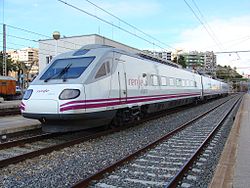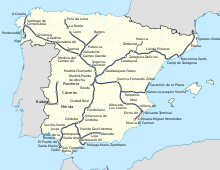
A tilting train is a train that has a mechanism enabling increased speed on regular rail tracks. As a train rounds a curve at speed, objects inside the train experience centrifugal force. This can cause packages to slide about or seated passengers to feel squashed by the outboard armrest, and standing passengers to lose their balance, or in such excessive speeds, could even cause the train to derail. Tilting trains are designed to counteract this by tilting the carriages towards the inside of the curve, thus compensating for the g-force. The train may be constructed such that inertial forces cause the tilting, or it may have a computer-controlled powered mechanism.

The Advanced Passenger Train (APT) was a tilting high speed train developed by British Rail during the 1970s and early 1980s, for use on the West Coast Main Line (WCML). The WCML contained many curves, and the APT pioneered the concept of active tilting to address these, a feature that has since been copied on designs around the world. The experimental APT-E achieved a new British railway speed record on 10 August 1975 when it reached 152.3 miles per hour (245.1 km/h), only to be surpassed by the service prototype APT-P at 162.2 miles per hour (261.0 km/h) in December 1979.
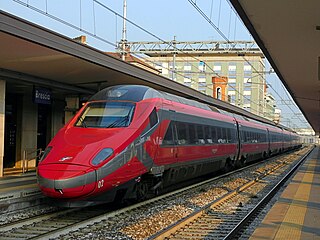
Pendolino is an Italian family of high-speed tilting trains used in Italy, Spain, Germany, Poland, Portugal, Slovenia, Finland, the Czech Republic, Slovakia, the UK, the US, Switzerland, China, and Greece. It was also used in Russia from December 12, 2010 until March 26, 2022. Based on the design of the Italian ETR 401, it was further developed and manufactured by Fiat Ferroviaria, which was taken over by Alstom in 2000.

SŽ series 310 is a high-speed tilting EMU used on the InterCitySlovenija premium train service in Slovenia, operated by Slovenske železnice since September 24, 2000. It is based on the Italian ETR 460 commonly known as Pendolino. The train is capable of reaching a maximum speed of 200 km/h. The train is electric single system - 3 kV DC.

Talgo is a Spanish manufacturer of intercity, standard, and high-speed passenger trains. Talgo is an abbreviation of Tren Articulado Ligero Goicoechea Oriol.

The New Pendolino is a class of high-speed tilting trains built by Alstom Ferroviaria for Trenitalia and Cisalpino.
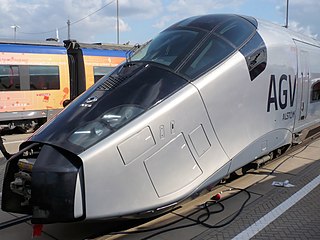
The AGV is a standard gauge, high-speed, electric multiple-unit train designed and built by Alstom.

An electric multiple unit or EMU is a multiple-unit train consisting of self-propelled carriages using electricity as the motive power. An EMU requires no separate locomotive, as electric traction motors are incorporated within one or a number of the carriages. An EMU is usually formed of two or more semi-permanently coupled carriages, but electrically powered single-unit railcars are also generally classed as EMUs. The great majority of EMUs are passenger trains, but versions also exist for carrying mail.

Alstom Ferroviaria S.p.A., formerly known as Fiat Ferroviaria S.p.A., is the Italian division of Alstom. Fiat Ferroviaria S.p.A. was the rail division of automobile manufacturer Fiat. It was founded in 1880 as Società Nazionale Officine di Savigliano. Fiat Ferroviaria began building locomotives in the 1930s. It became part of Fiat in 1970. Fiat Ferroviaria acquired the rail business of SIG of Switzerland in 1995, forming the subsidiary Fiat-Sig.

The Sm3 Pendolino is a class of high-speed body-tilting trains operated by VR Group. It is a member of the Pendolino train family; its design is based on the ETR 460. The first two trainsets were assembled in Finland by Rautaruukki-Transtech in the mid-1990s. The rest of the series of eighteen EMUs were built by Fiat Ferroviaria between 2000 and 2006. The trains serve most of Finland's major cities such as Helsinki, Turku, Oulu and Joensuu with a maximum speed of 220 km/h (140 mph), although this speed is only attained between Kerava and Lahti. The train has a power output of 4,000 kW (5,400 hp) and weighs 328 tonnes.
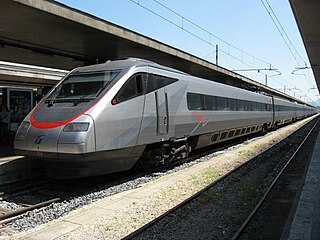
The ETR 480 is a tilting Electric Multiple Unit built by Fiat Ferroviaria since 1993, It is also known as Pendolino. It was developed from the first new-generation Pendolino, the ETR 460. The main difference between ETR 460, ETR 470 and ETR 480 is that the 460 run only on 3 kV DC, the 470 on both 3 kV DC and 15 kV AC, and the 480 on both 3 kV DC and 25 kV 50 Hz AC.

Stadler FLIRT is a passenger multiple unit trainset made by Stadler Rail of Switzerland. The baseline design of FLIRT is an electric multiple unit articulated trainset that can come in units of two to twelve cars with two to six motorized axles. The maximum speed is 200 km/h (125 mph). Standard floor height is 57 cm, but 78 cm high floors are also available for platform heights of 76 cm.

DBAG Class 411 and Class 415 are German tilting electric multiple-unit high-speed trains in service with DB Fernverkehr, commonly known as ICE T.

The DBAG Class 605, commonly known as the ICE TD is a high-speed diesel multiple unit (DMU) train, formerly in service with Deutsche Bahn and DSB.

The Renfe Class 130 or S-130 is a high-speed dual-gauge, dual-voltage trainset consisting of 11 Talgo VII tilting coaches and two power cars, used on Alvia and Euromed services. The class have been nicknamed patitos (ducklings), due to the shape of the train nose.
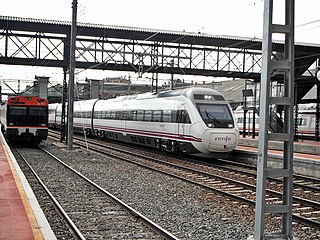
The Renfe Class 120 are electric multiple units used on Alvia high-speed rail services in Spain.

The ETR 460 is an electric multiple unit (EMU) tilting train produced by FIAT Ferroviaria since 1993. It is also known as the Pendolino after the family of trains from which it comes.
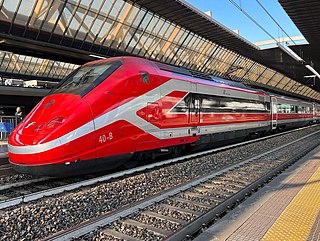
ETR 500 is a family of Italian high-speed trains built by AnsaldoBreda and introduced in 1993.

The CAF Civity is a platform of regional passenger trains which is manufactured by Spanish rolling stock manufacturer Construcciones y Auxiliar de Ferrocarriles. Available as both diesel, electric and battery-electric multiple unit, the Civity was first launched in 2010 and received its first order two years later.

The Caravaggio is an electric multiple unit (EMU) developed and built by Hitachi Rail Italy. It is named after the Italian Baroque painter Michelangelo Merisi da Caravaggio.
